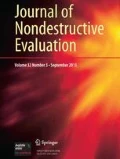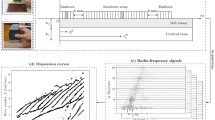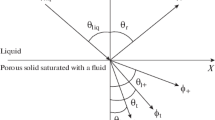Abstract
Bone is a biomaterial that has high resistance to fracture, but due to osteoporosis bone structure and properties deteriorates, which can lead to high fracture risk. Bio-inspired composites are an effective way to replace bone loss. We study here two bio-inspired composites, one inspired from circumferential lamella and the second from the compact bone properties respectively. The defects in bio-inspired composite materials can be detected using ultrasonic waves. The ultrasonic wave interaction with a medium can lead to information about its microstructure and material properties. To gain a better understanding of wave propagation through bio-inspired composites, ultrasound waves are modeled using the finite element method along with the Newmark’s constant acceleration method to study these composites with and without defects. For the bio-inspired composite based on circumferential lamella, we observe two in-plane energy flux waves. The faster quasi-longitudinal and the slower quasi-shear will deviate from the normal direction depending on the fiber orientation in the composites. The wave interaction with defects in bio-inspired composites will split the ultrasound wave into two components with finite energy peaks. We observe that the distance between these energy peaks of the waves correspond with the size of the defect in the composite. The change in the porosity of the bio-inspired composites causes a decrease in the maximum energy flux and wave speed. We also examine the use of biologically inspired signals, which has a lower relative attenuation with a higher frequency when compared to a typical transducer to study wave propagation in composites. For the cases studied in this paper, the different input signals show no significant difference in the peak-to-peak distance in energy flux after encountering a defect when compared to a sinusoidal signal.









Similar content being viewed by others
References
Hadjidakis, D.J., Androulakis, I.I.: Bone remodeling. Ann. N. Y. Acad. Sci. 1092(1), 385–396 (2006)
Johnell, O., Kanis, J.: An estimate of the worldwide prevalence and disability associated with osteoporotic fractures. Osteoporos. Int. 17(12), 1726–1733 (2006)
Kanis, J., et al.: European guidance for the diagnosis and management of osteoporosis in postmenopausal women. Osteoporos. Int. 19(4), 399–428 (2008)
Matsukawa, M.: Application of a micro-Brillouin light scattering technique to characterize bone in the GHz range. Ultrasonics 54(5), 6 (2014)
Morin, C., Hellmich, C.: A multiscale poromicromechanical approach to wave propagation and attenuation in bone. Ultrasonics 54(5), 1251–1269 (2014)
World Health Organization: Prevention and Management of Osteoporosis: Report of a WHO Scientific Group. Diamond Pocket Books (P) Ltd, New Delhi (2003)
Meziere, F., et al.: Measurements of ultrasound velocity and attenuation in numerical anisotropic porous media compared to Biot’s and multiple scattering models. Ultrasonics 54(5), 1146–1154 (2014)
Tatarinov, A., et al.: Multi-frequency axial transmission bone ultrasonometer. Ultrasonics 54(5), 1162–1169 (2014)
Egorov, V., et al.: Osteoporosis detection in postmenopausal women using axial transmission multi-frequency bone ultrasonometer: clinical findings. Ultrasonics 54(5), 1170–1177 (2014)
Cassereau, D., et al.: A hybrid FDTD-Rayleigh integral computational method for the simulation of the ultrasound measurement of proximal femur. Ultrasonics 54(5), 1197–1202 (2014)
Potsika, V.T., et al.: Application of an effective medium theory for modeling ultrasound wave propagation in healing long bones. Ultrasonics 54(5), 1219–1230 (2014)
Calle, S., et al.: Ultrasound propagation in trabecular bone: a numerical study of the influence of microcracks. Ultrasonics 54(5), 1231–1236 (2014)
Nagatani, Y., Mizuno, K., Matsukawa, M.: Two-wave behavior under various conditions of transition area from cancellous bone to cortical bone. Ultrasonics 54(5), 1245–1250 (2014)
Berteau, J.P., et al.: In vitro ultrasonic and mechanic characterization of the modulus of elasticity of children cortical bone. Ultrasonics 54(5), 1270–1276 (2014)
Baroncelli, G.I.: Quantitative ultrasound methods to assess bone mineral status in children: technical characteristics, performance, and clinical application. Pediatr. Res. 63(3), 220–228 (2008)
Nagatani, Y., et al.: Applicability of finite-difference time-domain method to simulation of wave propagation in cancellous bone. Jpn. J. Appl. Phys. 45(9R), 7186 (2006)
Fellah, Z.E.A., et al.: Ultrasonic wave propagation in human cancellous bone: application of Biot theory. J. Acoust. Soc. Am. 116(1), 61–73 (2004)
Bossy, E., et al.: Three-dimensional simulation of ultrasound propagation through trabecular bone structures measured by synchrotron microtomography. Phys. Med. Biol. 50(23), 5545 (2005)
Fratzl, P., et al.: Structure and mechanical quality of the collagen-mineral nano-composite in bone. J. Mater. Chem. 14(14), 2115–2123 (2004)
Launey, M.E., Buehler, M.J., Ritchie, R.O.: On the mechanistic origins of toughness in bone. Annu. Rev. Mater. Res. 40, 25–53 (2010)
Yoon, Y.J., Cowin, S.C.: The estimated elastic constants for a single bone osteonal lamella. Biomech. Model. Mechanobiol. 7(1), 1–11 (2008)
Haïat, G., et al.: Influence of a gradient of material properties on ultrasonic wave propagation in cortical bone: application to axial transmission. J. Acoust. Soc. Am. 125(6), 4043–4052 (2009)
Amini, A.R., Laurencin, C.T., Nukavarapu, S.P.: Bone tissue engineering: recent advances and challenges. Critical reviews\(^{{\rm TM}}\). Biomed. Eng. 40(5), 363–408 (2012)
Asa’ad, F., et al.: 3D-Printed scaffolds and biomaterials: review of alveolar bone augmentation and periodontal regeneration applications. Int. J. Dent. 2016, 1239842 (2016)
Kang, H.W., et al.: A 3D bioprinting system to produce human-scale tissue constructs with structural integrity. Nat. Biotechnol. 34(3), 312 (2016)
Cardoso, L., Cowin, S.C.: The role of microarchitecture on absorption and scattering of ultrasound waves in Trabecular bone. In: Poromechanics V@s Proceedings of the Fifth Biot Conference on Poromechanics. ASCE (2013)
Cardoso, L., Cowin, S.C.: Role of structural anisotropy of biological tissues in poroelastic wave propagation. Mech. Mater. 44, 174–188 (2012)
Cowin, S.C., Cardoso, L.: Fabric dependence of wave propagation in anisotropic porous media. Biomech. Model. Mechanobiol. 10(1), 39–65 (2011)
Nair, A.K., Kriz, R.D., Prosser, W.H.: Nonlinear elastic effects in graphite/epoxy: an analytical and numerical prediction of energy flux deviation. Wave Motion 51(7), 1138–1148 (2014)
Nair, A.K., Heyliger, P.R.: Elastic waves in combinatorial material libraries. Wave Motion 43(7), 529–543 (2006)
Reddy, J.N.: Energy Principles and Variational Methods in Applied Mechanics. Wiley, New York (1984)
Bathe, K.-J., Wilson, E.L.: Numerical methods in finite element analysis, p. 543. Prentice-Hall, Englewood Cliffs, NJ (1976)
Kriz, R.: Three visual methods: envisioning tensors, creating eigenvalue-eigenvector glyphs. http://www.esm.rkriz.net/classes/ESM5344/ESM5344_NoteBook/ESM4714/methods/EEG.html (2006)
Kriz, R.: Cijkl Glyphs. http://esm.rkriz.net/classes/ESM5344/ESM5344_NoteBook/Projects/Cijkl (2016). (Accessed 2016; open source code)
Kriz, R., Heyliger, P.: Finite element model of stress wave topology in unidirectional graphite/Epoxy: wave velocities and flux deviations. In: Review of Progress in Quantitative Nondestructive Evaluation. Springer, New York, pp. 141–148 (1989)
Hamed, E., Lee, Y., Jasiuk, I.: Multiscale modeling of elastic properties of cortical bone. Acta Mech. 213(1–2), 131–154 (2010)
Kriz, R., Stinchcomb, W.: Elastic moduli of transversely isotropic graphite fibers and their composites. Exp. Mech. 19(2), 41–49 (1979)
Kriz, R.D., Stinchcomb, W.: Mechanical properties for thick fiber reinforced composite materials having transversely isotropic fibers. No. VPI-E-77-13 (1977)
Hakim, I., et al.: The effect of manufacturing conditions on discontinuity population and fatigue fracture behavior in carbon/epoxy composites. In: AIP Conference Proceedings. AIP Publishing (2017)
Li, H., Zhou, Z.: Air-coupled ultrasonic signal processing method for detection of lamination defects in molded composites. J. Nondestruct. Eval. 36(3), 45 (2017)
Fierro, G.-P.M., et al.: Monitoring of self-healing composites: a nonlinear ultrasound approach. Smart Mater. Struct. 26(11), 115015 (2017)
Hamed, E., Jasiuk, I.: Multiscale damage and strength of lamellar bone modeled by cohesive finite elements. J. Mech. Behav. Biomed. Mater. 28, 94–110 (2013)
Baron, C., Talmant, M., Laugier, P.: Effect of porosity on effective diagonal stiffness coefficients (CII) and elastic anisotropy of cortical bone at 1 MHz: a finite-difference time domain study. J. Acoust. Soc. Am. 122(3), 1810–1817 (2007)
Lakshmanan, S., Bodi, A., Raum, K.: Assessment of anisotropic tissue elasticity of cortical bone from high-resolution, angular acoustic measurements. IEEE Trans. Ultrason. Ferroelectr. Freq. Control 54(8), 1560–1570 (2007)
Taylor, D., Lee, T.: Microdamage and mechanical behaviour: predicting failure and remodelling in compact bone. J. Anat. 203(2), 203–211 (2003)
Hopper, C., et al.: Bioinspired low-frequency material characterisation. Adv. Acoust. Vib. 2012, 9 (2012)
Acknowledgements
AKN, JL and MF would like to thank support from Department of Mechanical Engineering, University of Arkansas. Authors also acknowledge the support in part by the National Science Foundation under the Grants ARI#0963249, MRI#0959124 and EPS#0918970, and a Grant from Arkansas Science and Technology Authority, managed by Arkansas High Performance Computing Center. Authors also acknowledge discussions with Dr. Ronald Kriz regarding glyph generation for anisotropic materials.
Author information
Authors and Affiliations
Corresponding author
Ethics declarations
Conflict of interest
The authors declare that they have no conflict of interest
Electronic supplementary material
Below is the link to the electronic supplementary material.
Rights and permissions
About this article
Cite this article
Loving, J., Fielder, M. & Nair, A.K. A Numerical Approach to Predict Fracture in Bio-inspired Composites Using Ultrasonic Waves. J Nondestruct Eval 37, 43 (2018). https://doi.org/10.1007/s10921-018-0497-x
Received:
Accepted:
Published:
DOI: https://doi.org/10.1007/s10921-018-0497-x




